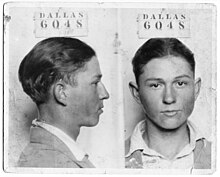Bonnie & Clyde
| Bonnie Parker and Clyde Barrow | |
|---|---|

Bonnie and Clyde in March 1933 in a photo found by police at the Joplin, Missouri hideout
|
| Bonnie Parker | |
|---|---|

Parker with 1932 Ford V-8 B-400 convertible coupe.
|
|
| Born |
Bonnie Elizabeth Parker October 1, 1910 Rowena, Texas |
| Died | May 23, 1934 (aged 23) Bienville Parish, Louisiana 32°26′28″N 93°05′34″W / 32.441217°N 93.092659°W |
| Cause of death | Gunshot wound by law enforcement |
| Resting place | Crown Hill Memorial Park Dallas, Texas |
| Nationality | American |
| Spouse(s) | Roy Thornton (m. 1926–34; her death) |
| Clyde Barrow | |
|---|---|

Clyde Barrow in 1926, aged 17
|
|
| Born |
Clyde Chestnut Barrow March 24, 1909 Ellis County, Texas |
| Died | May 23, 1934 (aged 25) Bienville Parish, Louisiana 32°26′28″N 93°05′34″W / 32.441217°N 93.092659°W |
| Cause of death | Gunshot wound by law enforcement |
| Resting place | Western Heights Cemetery Dallas, Texas |
| Nationality | American |
| Height | 5 ft 6 in (1.68 m) |
Bonnie Elizabeth Parker (October 1, 1910 – May 23, 1934) and Clyde Chestnut Barrow also known as Clyde Champion Barrow (March 24, 1909 – May 23, 1934) were American criminals who traveled the central United States with their gang during the Great Depression, robbing people and killing when cornered or confronted. Their exploits captured the attention of the American public during the "Public Enemy Era," between 1931 and 1935. Though known today for their dozen-or-so bank robberies, the duo most often preferred to rob small stores or rural gas stations. The gang is believed to have killed at least nine police officers and several civilians. The couple was eventually ambushed and killed by law officers near Sailes, Bienville Parish, Louisiana. Their reputation was revived and cemented in American pop folklore by Arthur Penn's 1967 film Bonnie and Clyde.
Even during their lifetimes, their depiction in the press was at considerable odds with the hardscrabble reality of their life on the road, especially for Bonnie Parker. While she was present at a hundred or more felonies during the two years she was Barrow's companion, she was not the cigar-smoking, machine gun-wielding killer depicted in the newspapers, newsreels, and pulp detective magazines of the day. Gang member W. D. Jones later testified he could not recall ever having seen her shoot at a law officer, and the cigar myth grew out of a playful snapshot police found at an abandoned hideout. It was released to the press and published nationwide. While Parker did chain smoke Camel cigarettes, she never smoked cigars.
According to historian Jeff Guinn, the hideout photos led to Parker's glamorization and the creation of legends about the gang. He writes:
John Dillinger had matinee-idol good looks and Pretty Boy Floyd had the best possible nickname, but the Joplin photos introduced new criminal superstars with the most titillating trademark of all—illicit sex. Clyde Barrow and Bonnie Parker were wild and young, and undoubtedly slept together.
...
Wikipedia
